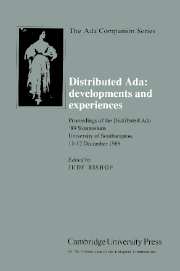 Distributed Ada: Developments and Experiences
Distributed Ada: Developments and Experiences Book contents
- Frontmatter
- Contents
- Preface
- Distributed Ada – the Issues
- Distributed Ada – a Case Study
- Parallel Ada for Symmetrical Multiprocessors
- The York Distributed Ada Project
- From DIADEM to DRAGOON
- Honeywell Distributed Ada – Approach
- Honeywell Distributed Ada – Implementation
- Ada for Tightly Coupled Systems
- A Pragmatic Approach to Distributed Ada for Transputers
- Distributed Ada on Shared Memory Multiprocessors
- The MUMS Multiprocessor Ada Project
- A Portable Common Executable Environment for Ada
- Supporting Reliable Distributed Systems in Ada 9X
A Portable Common Executable Environment for Ada
Published online by Cambridge University Press: 13 October 2009
- Frontmatter
- Contents
- Preface
- Distributed Ada – the Issues
- Distributed Ada – a Case Study
- Parallel Ada for Symmetrical Multiprocessors
- The York Distributed Ada Project
- From DIADEM to DRAGOON
- Honeywell Distributed Ada – Approach
- Honeywell Distributed Ada – Implementation
- Ada for Tightly Coupled Systems
- A Pragmatic Approach to Distributed Ada for Transputers
- Distributed Ada on Shared Memory Multiprocessors
- The MUMS Multiprocessor Ada Project
- A Portable Common Executable Environment for Ada
- Supporting Reliable Distributed Systems in Ada 9X
Summary
INTRODUCTION
Perhaps the greatest challenge facing Ada is in the domain of the large distributed real-time system. Because of the long lead time associated with such complex applications no real experience of the use of Ada, in this type of domain, has yet been gained. Nevertheless there are projects of a large and complex nature that are committed to the use of Ada, even though the full potential of the language has yet to prove itself in this challenging domain.
The Portable Common Execution Environment (PCEE) project is a research effort addressing the life cycle support of large, complex, non-stop, distributed computing applications with Mission And Safety Critical (MASC) components. Such applications (for example the International Space Station — Freedom) typically have extended life-time (e.g., 30 years) requirements. PCEE focuses on the system software, the interface to applications and the system architecture necessary to reliably build and maintain such systems. The requirements extend from the target system environment to the integration environment, and ultimately to the host environment. The integration environment serves as the single logical point of integration, deployment, and configuration control whereas system development occurs in the host environment. Life cycle issues include an integrated approach to the technologies (environments, tools, and methodologies) and theoretical foundations (models, principles, and concepts) that span these three environments. The scope of the effort is necessarily broad. There are, however, substantial research foundations to support development across the breadth of the project.
- Type
- Chapter
- Information
- Distributed Ada: Developments and ExperiencesProceedings of the Distributed Ada '89 Symposium, University of Southampton, 11–12 December 1989, pp. 259 - 291Publisher: Cambridge University PressPrint publication year: 1990


